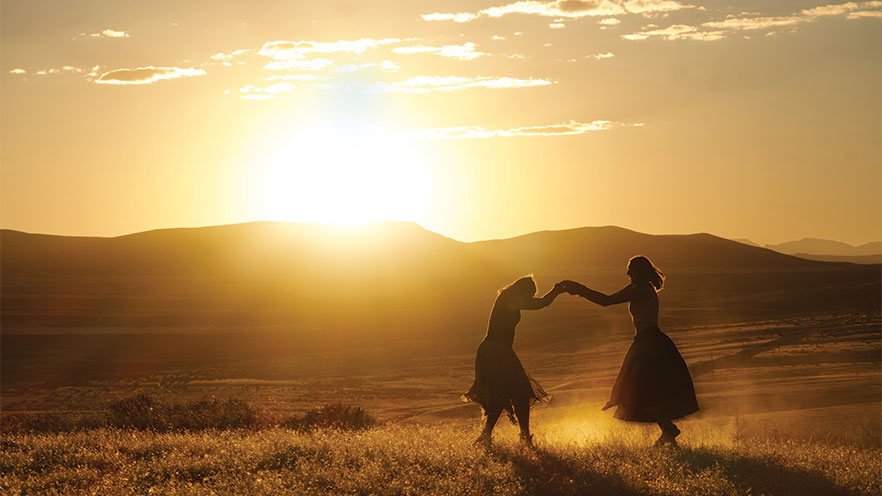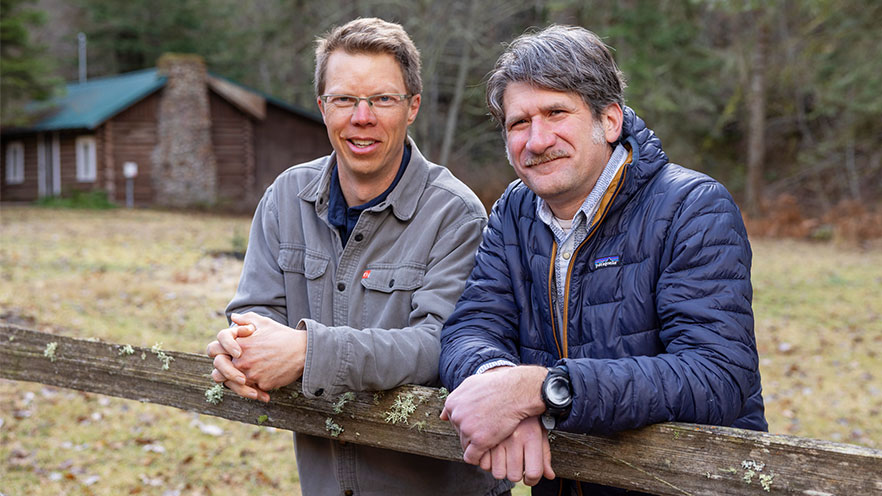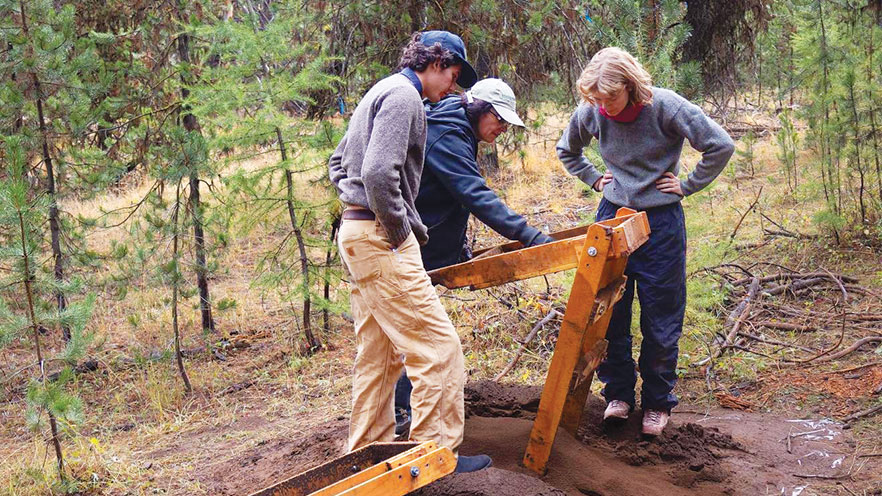Semester in the West Explores New Directions
New faculty leaders share their vision for building on the program’s rich traditions
By Tara Roberts

A delicate dance. In Thacker Pass, Nevada, students spoke with scientists and Indigenous activists about their differing perspectives on plans for a local lithium mine. Photo by Henry Anderson ’27.
On a cool, gray morning in September 2024, a group of Whitman College students glided through the Snake River Canyon on a jet boat with Nez Perce tribal tourism leaders and storytellers. The community partners shared geological and cultural history, traditional stories, and personal memories as they passed towering hills and craggy cliffs, stopping for the students to visit ancient rock art and swim in the cold water.
The trip was part of Semester in the West, Whitman’s signature interdisciplinary field program where students spend 14 weeks over the fall semester on the road learning about the interior American West.
The program—founded and led for 20 years by Professor of Politics Phil Brick—has entered a new era since Brick’s retirement.
A team of faculty co-directors will now rotate responsibilities for planning and leading the trip. The Fall 2024 program, the first under the new model, was co-led by Lyman Persico (Associate Professor of Geology and Environmental Studies) and Stan Thayne (Senior Lecturer of Anthropology, Environmental Studies and Religion) with Aaron Strain (Baker Ferguson Chair of Politics and Leadership) as the Environmental Humanities field-intensive faculty.
The moment on the Snake exemplified the program’s 2024 theme, “Water in the West,” and illustrated the layers of experience and education students gain when they become Westies as well as Whitties.
“The students really loved it, in part because it was a day out on the river and they were able to see this beautiful space and experience it in their bodies—but also because of the people we were with,” Thayne says. “The Nez Perce storytellers and leaders who were sharing helped students see the river not just as a recreational space, but as the Nez Perce homeland.”
After an epic semester of academic adventure, filled with experiences like that meaningful day on the Snake, Persico and Thayne are excited to continue building on Brick’s legacy while guiding Semester in the West’s evolution.

Trusted leaders lean in to one epic field trip. Semester in the West co-directors (from left) Stan Thayne and Lyman Persico are part of a faculty team reimagining the next evolution of Whitman’s landmark field program.
A Pivotal Moment
Persico heard about Semester in the West shortly after arriving at Whitman in 2015.
“It was clear immediately how transformative an experience it was,” he says.
In the years leading up to Brick’s retirement, Persico knew the program would be at a crossroads and wanted to be involved in the transition.
Thayne, who came to Whitman in 2016, loved the idea of a field trip that immerses students in “the rhythms of outdoor life” and started imagining the possibilities too.
The two joined forces with Strain, Eunice Blavascunas (Associate Professor of Anthropology and Environmental Studies) and M Acuff (Professor of Art), and the team received a Whitman Pedagogical Inquiry Grant to reimagine Semester in the West.
The new multi-instructor model is designed to be more equitable for faculty. Instead of one person leading the entire program, two faculty members spend roughly half the semester each in the field. A third faculty member takes on a lighter load while learning the program’s inner workings.
Because the faculty will rotate every year, students will experience a wider diversity of perspectives.
“We’re going to depend on the faculty to lean into their expertise,” Persico says. “We’ll have different themes depending on who’s running the course.”
The model also doubles the program’s capacity. Traditionally, Semester in the West happened every two years. The faculty team plans to expand it to every fall, beginning with a test run in 2024 and 2025.

Sifting the past. Students participated in an active dig site at the Maxville Heritage Interpretive Center, a historic logging community in eastern Oregon.
Testing the Waters
This fall’s cohort spent about half of the semester revisiting sites from years past, maintaining relationships Brick had fostered over two decades at the helm. The other half built on Thayne’s and Persico’s interests and connections.
Thayne led the program’s northern leg, drawing on his knowledge of fishery resources and Indigenous politics. Students visited sites such as the Colville Tribe’s Chief Joseph Fish Hatchery near Washington’s Grand Coulee Dam and the Klamath River Basin in Oregon and California, home to the largest dam-removal project in North American history.
Persico, whose areas of expertise include hydrology and western water issues, led the southern leg. Students traveled through the Upper Colorado River Basin to Albuquerque, New Mexico, where hundreds of thousands of people outside the basin rely on its water. They then traveled through the lower Colorado River Basin and camped between the dwindling Salton Sea and lush fields of irrigated alfalfa in Southern California’s Imperial Valley.
“It was cool for the students to be in these landscapes, not just seeing a map in the classroom,” Persico says.
Throughout the program, students build a strong sense of community while gaining deeper knowledge of public lands conservation and rural life. For their final projects, they created and presented written, audio and multimedia stories about their journey. In 2024, Strain led two weeklong writing workshops in the field to help students develop their work.
“They learned all these skills and also have a much better mental geography of the spaces we moved through—the issues that people are facing or waking up every day and working on or dealing with in these spaces,” Thayne says.
“It was cool for the students to be in these landscapes, not just seeing a map in the classroom.
”
Lyman Persico, Associate Professor of Geology and Environmental Studies and Co-Director of Semester in the West
Forging Forward
Persico and Blavascunas will lead the 2025 program, with Acuff in the lighter role. The theme, “Forests and Deserts,” will explore the interplay of geography and climate, the environmental problems faced in different regions, and topics such as green energy and mining.
As they look to the future, the co-directors hope to continue Semester in the West’s tradition of changing students’ lives through their experiences across the landscape and with the people they meet along the way. “That's what a place like Whitman can do,” Persico says. “My long-term goal is to make sure that Whitman can provide this opportunity to the next 20 or 30 years of students.”
Dive Deeper: Western Reflections
Westies capture their reflections on the road through multimedia storytelling. Their photos, blogs, essays and more are available at semesterinthewest.org. Check out:
Carlie Johnson ’27, “A Rock and a Hard Place”
Johnson discusses how the loss of traditional salmon runs has affected the Upper Columbia United Tribes.
Jackson Schroeder ’26, “Meet our Guests: Helena Cappon”
Schroeder profiles Cappon, who opened a mom-and-pop pizza and ice cream shop in rural Walsenburg, Colorado.
Ayano Yoshikawa ’27, “Landscape and Stories”
While camping under the night sky on the Nez Perce reservation, Yoshikawa reflects on living in a starless city, Tokyo.
Owen Schott ’25, “Terrorists and Angels, Water Caches in the American Southwest”
Schott argues for the heroism of Tohono O’odham activist Mike Wilson, who has faced opposition for leaving water caches for migrants in the Arizona desert.